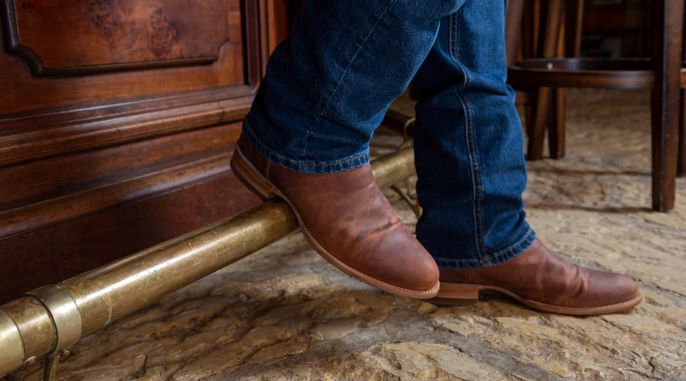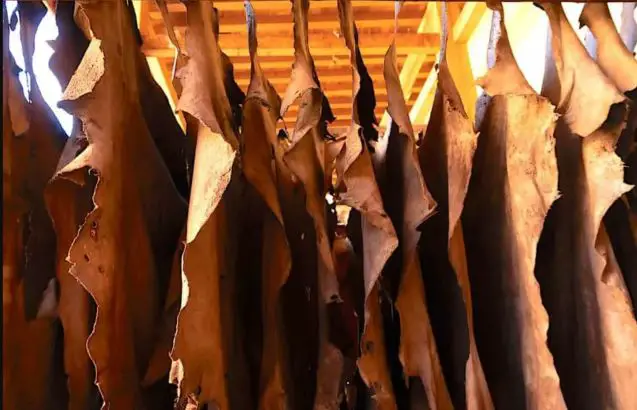When selecting a type of leather boot, there are quite a number of choices and all different prices. For those looking for hardy leather at a reasonable price, goat leather is a great choice.
It’s both lightweight and soft, yet durable at the same time. Another name for this type of leather is Moroccan leather. This kind of leather is developed from the hide of a goat.
Thanks to its strength and flexibility it is appreciated by makers of leather goods including boot manufacturers.

Goat Leather: What Is It?
This begins with a selection of goat hide that is then treated to become goat leather. It is characterized by durability, flexibility, and tough strength.
Goat leather is most often used for small leather accessories because of the smaller size of the animal when compared to cowhide.
Where Are Goats Found?
Nowadays, the majority of the globe’s goat population can be found in Asia with over 60% raised there. They are raised in Bangladesh, China, India, and Pakistan. Goats were domesticated as far back as 10,000 years ago.
Goat Leather Qualities
Goat leather possesses a number of desirable qualities. Consider these when considering a pair of boots in goat leather.
1.) Durability
Goat leather is appreciated for its longevity despite use. It’s as durable as other leathers if not more so in some cases.
2.) Flexible and Soft
Goat skin is appreciated for its flexibility and soft feel. It is not stiff as cowhide can be. A goat’s skin produces lanolin making the leather have a soft, flexible quality.
3.) Improves with Age
Goat skin, like a fine wine, improves its attractiveness with age. Scratches and scuffs will only improve the look.
4.) Lightweight
Goat skin is thinner than other kinds of animal hides, making it lighter in weight.
5.) Strength
For as much as goat skin is soft, it is also strong and hard-wearing. It can support design tension in stitching and will retain its shape.
6.) Water Resistant
Goat leather boasts a certain resistance to water after its tanning process.
How Is Goat Skin Prepared?
Raw goat hides are thoroughly cleaned. Excess flesh and hair is removed, and fat, oil, and tissue are eliminated from the hide through washing. This prepares the hide for tanning.
Tanning is the process utilized to convert goat hide into goat leather. Tanning stabilizes rawhide protein, thus preventing it from decaying. When tanning is completed, the leather hide can be used for leather goods production.

1.) Chrome Tanning Process
Developed in the mid-19th century, this process uses chemicals. Raw goat hide is soaked in a chemical solution that contains metal chromium.
This process is used often for the tanning of goat leather because it aids in making leather water resistant. It also contributes to making leather suppler and softer.
Chrome leather tanning is less expensive than the alternative of vegetable tanning because it only requires 24 hours to a couple of days.
As a result, approximately 90% of leather today is tanned this way. Leather tanned this way is considered to have greater resistance to water, suppler, and as holding dye better. It can crack however if not conditioned at regular intervals.
Chrome tanning does however pose a risk to the environment. The solution from chromium salt is a pollutant for water sources and can cause health issues. An example is Kanpur with large numbers of respiratory issues, birth defects, and renal failure.
2.) Vegetable Tanning Process
This process is the more traditional method for tanning goat skin. It dates back to almost 6,000 BC. This method uses only natural products. Goat skin is soaked in fat liquors and vegetable tannins rather than in chemicals.
This is a method that consumes lots of time as it requires more than one soak. Vegetable tanning processes can require as much as 30 days to complete, so costs will be higher.
It is tough and hard-wearing. It may make leather momentarily a bit stiffer, but molds well to your feet with time and will develop a patina faster.
3.) Oil Tanning Process
This is a kind of chrome tanning. Oils such as white mineral oil are included to improve water resistance. As a moist leather, it requires less conditioning.
4.) Combination Tanning
This process uses vegetable matter and chromium salt solution to tan leather.
What Is Goat Skin Used to Produce?
Goat leather is used to make products that require softness but wear resistance. Some examples include:
-
-
- Boots
- Gloves
- Jackets
- Notebook covers
- Purses
- Shoes
- Wallets
-
What Is It Like Working with Goat Leather?
Goat leather offers a tight grain fiber structure. Its surface is uniform in texture and boasts a certain stretch ability making it perfect for product manufacturing that requires flexibility.
It is soft and supple to the touch meaning that it is ideal for inside linings as well as the exterior of leather products.
Goat leather is particularly adaptable to designs using a turned edge. It does not burnish well like cowhide. It gives outstanding results especially when hot foil stamps for logos are desired on leather products.
Is Goat Leather Good?
Goat leather is an excellent leather that boasts exceptional durability. It also can be very affordably priced depending on the brand, kind, and boot style you select.
It can have an intolerable smell, but this can be eliminated by spraying it with a solution of water and vinegar. You can also treat the leather in a plastic bag with baking soda for 48 hours.
How Does Goat Leather Compare?
| Cowhide | Goat Skin | Lamb Skin | Sheep Skin | |
| Leather Strength | 5/5 | 4/5 | 3.5/5 | 3/5 |
| Stretch capability | 1/5 | 3/5 | 3.5/5 | 5/5 |
| Insulation | 5/5 | 4/5 | 3/5 | 3/5 |
| Weight | 5/5 | 4/5 | 3/5 | 3/5 |
| Skin softness | 2/5 | 3/5 | 5/5 | 5/5 |
Are Goat Leather Boots Good?
Goat leather is neither a luxury leather like alligator, ostrich, snake, or sharkskin, nor is it a cheap leather. It is a well-balanced leather that works well for boot production.
-
-
- Goat leather boots are breathable and cool due to the characteristic pores.
- They are soft and supple allowing for the goat leather to be styled in many ways.
- Goat leather is amenable to many colors as it can easily be dyed.
- This leather can be split and shaved.
- They can be more affordable.
-
In Conclusion
Goat leather is the perfect compromise between luxury leathers and inexpensive leathers. Goat skin leather boots are durable and the leather features numerous pores that make it softer, more breathable, and cooler in hot weather.
It is exceptionally flexible and can be dyed into a multitude of colors offering numerous style options for color and design. Goat leather also will soften with wear. Are goat leather boots good? You bet!







